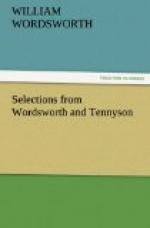Yet in these thoughts myself almost despising,
Haply I think on thee—and then my state,
Like to the lark at break of day arising
From sullen earth, sings hymns at heaven’s gate;
For thy sweet love remember’d such wealth brings,
That then I scorn to change my state with kings.”
It is Milton’s merit that he rescued the sonnet from the snare of verbal wit in which the Elizabethans had involved it, and made it respond to other passions than that of love. His sonnets, as imitations of the Italian form, are more successful than the scattered efforts in that direction of Wyatt and Surrey. They are indeed regular in all respects, save that he is not always careful to observe the pause in the thought, and the subtle change which should divide the octave from the sestet.
After Milton there is a pause in sonnet-writing for a hundred years. William Lisles Bowles (1762-1850), memorable for his influence upon Coleridge, was among the first again to cultivate the form. Coleridge and Shelley gave the sonnet scant attention, and were careless as to its structural qualities. Keats, apart from Wordsworth, was the only poet of the early years of the century who realized its capabilities. He has written a few of our memorable sonnets, but he was not entirely satisfied with the accepted form, and experimented upon variations that cannot be regarded as successful.
There is no doubt that the stimulus to sonnet-writing in the nineteenth century came from Wordsworth, and he, as all his recent biographers admit, received his inspiration from Milton. Wordsworth’s sonnets, less remarkable certainly than a supreme few of Shakespeare’s, have still imposed themselves as models upon all later writers, while the Shakespearean form has fallen into disuse. A word here, therefore, as to their form.
The strict rime movement of the octave a b b a a b b a is observed in seven only of the present collection of twelve, namely, in the first sonnet, the second, the third, the fifth, the sixth, the seventh, and the eighth. The rime formula of the octave with which Wordsworth’s name is chiefly associated is a b b a a c c a. The sonnets in which this additional rime is introduced are the fourth, the ninth, the tenth, the eleventh and the twelfth.
As regards the transition from octave to sestet the following sonnets observe the prescribed law, namely, the second, third, sixth, seventh, and ninth. The seven remaining sonnets all show some irregularity in this respect. The first sonnet (Fair Star) with its abrupt enjambement at the close of the octave, and the thought pause in the body of the first line of the sestet, is a form much employed by Mrs. Browning, but rigorously avoided by Dante Gabriel Rossetti with his more scrupulous ideal of sonnet construction. This imperfect transition is seen again in the fourth, fifth, eighth, tenth, eleventh, and twelfth sonnets. Its boldness certainly amounts to a technical fault in the two sonnets on King’s College Chapel.




